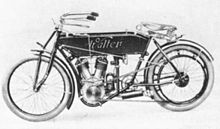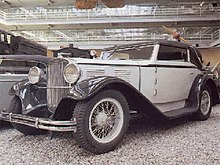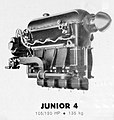Walter Engines
| Walter Engines
|
|
|---|---|
| legal form | |
| founding | 1911 |
| Seat |
Prague , Czech Republic |
| Branch | Engine construction |
| Website | www.walterengines.com |
Walter Engines is a Prague- based Czech manufacturer of turbo engines for small aircraft and components for aircraft engines . The company manufactures, among other things, the Walter M601 turboprop engine , which has been built over 1500 times since 1975 and which was also used for the Let L-410 . From 1913 onwards, cars were also produced, initially own models and later Fiat 508 and Fiat 514 under license. The car production was only stopped in 1954.
history
The Walter company was founded in Prague in 1911 . Josef Walter (1873–1950) trained in his father's locksmith 's workshop. After he first built bicycles and motorcycles , he started making tricycles in 1919 . In 1913 the first passenger cars were built in Prague-Jinonitz . Walter vehicles competed in many important races up until the First World War .
Beginnings with motorcycles and tricycles
Walter's first motorcycle was a single-cylinder model with a displacement of 200 cc and 1.5 hp. The second, somewhat stronger model received a silver medal at the Prague industrial exhibition. After starting series production of the motorcycle, in 1905 he moved into a new workshop with a forge, paint shop, modern machines and a design office. The successful single-cylinder machine was soon followed by a two-cylinder model and other motorcycles that were also suitable for sidecar use. The Walter motorcycles were very successful at racing events. They were exported to Russia and the Balkans.
In 1909 Walter built his first multi-track automobile , a three-wheeler with an air-cooled 1000 cm³ two-cylinder engine with 8 hp and a second model with a displacement of 1.2 l and 12 hp. The vehicles had one wheel at the front and two at the rear, as well as a two-speed gearbox and chain drive . Almost 900 vehicles were sold between 1910 and 1913. The tricycles were successful in hill climbs.
Beginning of car manufacturing
In 1913 the first passenger car (W-III or unit type) with a side-controlled four - cylinder with 26 hp was developed. The open four-seater had a four-speed gearbox and spoked wheels. The top speed was 90 km / h. A short time later, the W-II 18/20 PS and WI 14 PS models appeared. The vehicles only differed in their motorization. Before automobile production began, Walter founded the Josef Walter und Co. GmbH motor vehicle factory in Prague-Jinozitz . The factory was closed during the First World War and production could not be resumed until 1919.
New beginning after the First World War
The first new model was WZ (Walter-Zubaty) with a side-controlled 18 HP engine and a 20 HP OHV engine . The WIZI 8/25 PS followed in 1923 with a displacement of 2.1 l and 25 PS. This car was the basis for the WZ racing car with a 2 liter bevel motor and 80 hp. Many successes could be achieved with this racing car. At the 8th hill climb in 1924, the Zbraslav-Jíloviště works driver Jindrich Knapp was able to achieve third place behind two supercharged Mercedes , at the Karlsbad hill climb Knapp was able to beat the racing driver Vinzenz Junek in a Bugatti Type 35 . Between 1924 and 1928, the P models appeared with differently powerful engines.
In 1922 Josef Walter left the company, probably because of a dispute with his financial partner Košíře, and founded a gear factory. The name Walter was retained for the automobile factory. Teny Kumpera became the general manager. In the same year, the first aircraft engines were built under a BMW license , the water-cooled six-cylinder W-III with 185 hp and the W-IV with 245 hp. The air-cooled five-cylinder NZ with 60 hp was an in-house development. Many cars, trucks and buses were produced until 1928. Between 1928 and 1931 the FA Barvitius designed car models 4 B, 6 B, Standard, Super and Regent with outputs from 30 to 80 hp appeared.
In the 1930s, various Bristol engines such as Jupiter , Mercury and Pegasus were also produced under license before their own air-cooled four and six-cylinder engines and, from 1936, an air-cooled V12 engine ( Walter Sagitta ) were produced.
In 1931 a license agreement was concluded with Fiat , Walter supplied aircraft engines to Fiat and in return built the Fiat 514 under the name Walter Bijou and from 1932 the Fiat 508 (Balilla) as Walter Junior in various performance levels. The last models were the Walter Prince and the Walter Lord. The Junior SS was also very successful as a racing car. In the 1000 mile races in Czechoslovakia in 1933/34, the racing driver Knapp was class winner. In the 1930s, various trucks were also built under Junkers and Fiat licenses. A bus with a Royal engine enlarged to 7.5 liters reached a top speed of 120 km / h. This engine was also used in fire engines.
During the Second World War, Walter produced Argus engines under license for Germany.
After the Second World War
The Walter company survived the war undamaged and was nationalized as Motorlet NE in 1946 . He produced piston engines approved by the Soviet Union and started production of the Walter M05 jet engine in 1952 . This was a version of the Soviet Klimow WK-1 engine, based on the Rolls-Royce Nene , which powered the MiG-15 and was exported to many countries. The company produced a number of other Soviet engines during the 1950s and 1960s, although piston engine production had been closed and transferred to the Czechoslovak aircraft manufacturer Avia in 1964 .
In 1995 the company was privatized as Walter as and in 2005 the engine department became Walter Maschinen as. In July 2006 it was acquired by the Czech investment company FF Invest . In March 2007 it was announced that Walter Engines as would merge with Avia's engine division.
In September 2007 it was announced that the business assets (apart from the service company in Prague) had been bought by the American engine manufacturer GE Aviation .
Walter Royal
The top model in car production in 1931 was the twelve-cylinder Walter Royal. These vehicles were very well equipped and were also known as the Czechoslovak Rolls-Royce. Only five of these cars were built. Since Kumpera had worked in France for a long time, including at Hispano-Suiza , Gnôme et Rhône and Peugeot , and was an admirer of Bugatti , he commissioned his chief designer to build a twelve-cylinder vehicle. This was called Walter Royal based on the Bugatti Royale . The 5.9-liter twelve-cylinder V-engine developed 88 kW at 3800 rpm. It was an OHV engine with a central camshaft, a crankshaft with seven bearings, a vibration damper and pressure circulation lubrication with a gear pump. In the V of the cylinder was the alternator, which had a common drive with the water pump and the cooling fan. The mixture was prepared either with Solex flat -stream individual gasifiers or with two Stromberg downdraft gasifiers . The customer could choose between two transmissions: a ZF phone transmission with four gears or a Maybach transmission with three gears and pneumatically shifted countershaft . A special feature of the Royal was a hydraulic Lockheed brake that was operated by a Bosch Dewandre servo device. This ensured that one axis would still be braked in the event of a system failure. The last Royal left the factory in 1933. After that, only the Super and the Regent were built, and finally Fiat vehicles were manufactured under license .
Walter Automobile
| Type | Construction year | cylinder | Cubic capacity cm³ | power | Wheelbase mm | Track mm |
|---|---|---|---|---|---|---|
| W-III | 1913 | 4R SV | 2600 | 26 hp | 2600 | k. A. |
| W-II | 1913 | 4R SV | 1840 | 20 hp | 2570 | k. A. |
| WI | 1913 | 4R SV | 1240 | 14 hp | 2560 | k. A. |
| WZ | 1919 | 4R SV | 1540 | 18 hp | 2760 | 1200 |
| WIZ | 1920 | 4R OHV | 1540 | 20 hp | 2760 | 1200 |
| WIZI | 1922 | 4R SV | 2120 | 25 hp | 2825 | 1200 |
| PI | 1924 | 4R OHV | 1540 | 20 hp | k. A. | k. A. |
| P-II | 1924 | 4R OHV | 1945 | 25 hp | k. A. | k. A. |
| P-III | 1925 | 4R OHV | 1945 | 30 hp | 3100 | 1400 |
| P-IV | 1928 | 4R OHV | 2300 | 35 hp | 3100 | 1400 |
| 4-B | 1928 | 4R OHV | 1908 | 35 hp | 2800 | 1380 |
| 6-B | 1928 | 6R OHV | 2860 | 60 hp | 3300 | 1400 |
| default | 1930 | 6R OHV | 2500 | 65 hp | 3300 | 1400 |
| great | 1931 | 6R OHV | 3257 | 70 hp | 3600 | 1450 |
| regent | 1931 | 6R OHV | 3257 | 80 hp | 3600 | 1450 |
| Royal | 1931 | 12V OHV | 5874 | 120 hp | 3700 | 1450 |
Automobiles under Fiat license
| Type | Construction year | cylinder | Cubic capacity cm³ | power | Wheelbase mm | Track mm | |
|---|---|---|---|---|---|---|---|
| Bijou | 1931 | 4 SV | 1438 | 32 hp | 2555 | 1220 | Fiat 514 |
| Junior | 1932 | 4 SV | 995 | 22 hp | 2250 | 1220 | Fiat 508 |
| Junior S | 1933 | 4 SV | 995 | 30 hp | 2250 | 1220 | Fiat 508 |
| Junior SS | 1933-1934 | 4 OHV | 995 | 35 hp | 2250 | 1220 | Fiat 508 |
| prince | 1933 | 6 SV | 2491 | 60 hp | 2775 | 1400 | Fiat 522 |
| lord | 1933 | 6 SV | 2491 | 60 hp | 2875 | 1400 | Fiat 522C |
From 1945 to 1947, at least part of the production of the Aero Minor II took place in the Walter factory . Walter has only built aircraft engines since 1948.
Engines
Some engines:
- Walter Atlas
- Walter Atom
- Walter Bora
- Walter Castor
- Walter Gemma
- Walter Junior
- Walter M208
- Walter M332
- Walter M337
- Walter M601
- Walter Major
- Walter Mars
- Walter Mikron
- Walter Minor
- Walter NZ 40
- Walter NZ 60
- Walter NZ 85
- Walter NZ 120
- Walter Pollux
- Walter Regulus
- Walter Sagitta
- Walter Scolar
- Walter Super Castor
- Walter Titan
- Walter Vega
- Walter Venus
Walter Atom (1934)
Walter Bora (1934)
Walter Castor (1928)
Walter Gemma (1933)
Walter Junior 4 (1934)
Walter NZ-85 (1926-1930)
Walter Pollux II (1934)
Walter Regulus II (1934)
literature
- Václav Petřík: twelve-cylinder from Prague . In: Automobil und Motorrad Chronik, issue 4/1975, pages 28 and 29
- Václav Petřík: Walter: Tradition on two, three and four wheels. In: Auto und Motorrad Chronik, issue 6/1978, pages 22–23 and 40.
Web links
Individual evidence
- ↑ Zahnradfabrik Friedrichshafen (accessed on September 2, 2014)

















